Sepp Hochreiter
Pre-trained Forecasting Models: Strong Zero-Shot Feature Extractors for Time Series Classification
Oct 30, 2025Abstract:Recent research on time series foundation models has primarily focused on forecasting, leaving it unclear how generalizable their learned representations are. In this study, we examine whether frozen pre-trained forecasting models can provide effective representations for classification. To this end, we compare different representation extraction strategies and introduce two model-agnostic embedding augmentations. Our experiments show that the best forecasting models achieve classification accuracy that matches or even surpasses that of state-of-the-art models pre-trained specifically for classification. Moreover, we observe a positive correlation between forecasting and classification performance. These findings challenge the assumption that task-specific pre-training is necessary, and suggest that learning to forecast may provide a powerful route toward constructing general-purpose time series foundation models.
Addressing Pitfalls in the Evaluation of Uncertainty Estimation Methods for Natural Language Generation
Oct 02, 2025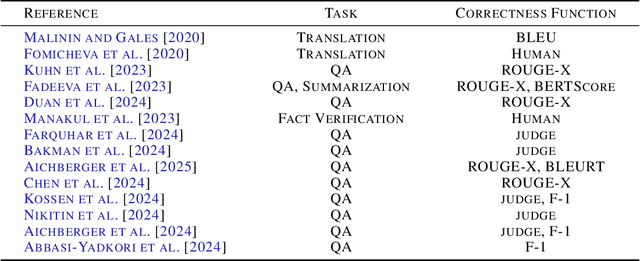

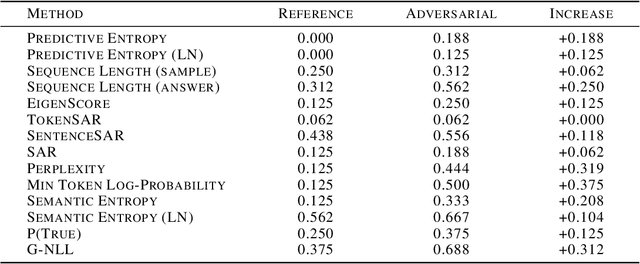

Abstract:Hallucinations are a common issue that undermine the reliability of large language models (LLMs). Recent studies have identified a specific subset of hallucinations, known as confabulations, which arise due to predictive uncertainty of LLMs. To detect confabulations, various methods for estimating predictive uncertainty in natural language generation (NLG) have been developed. These methods are typically evaluated by correlating uncertainty estimates with the correctness of generated text, with question-answering (QA) datasets serving as the standard benchmark. However, commonly used approximate correctness functions have substantial disagreement between each other and, consequently, in the ranking of the uncertainty estimation methods. This allows one to inflate the apparent performance of uncertainty estimation methods. We propose using several alternative risk indicators for risk correlation experiments that improve robustness of empirical assessment of UE algorithms for NLG. For QA tasks, we show that marginalizing over multiple LLM-as-a-judge variants leads to reducing the evaluation biases. Furthermore, we explore structured tasks as well as out of distribution and perturbation detection tasks which provide robust and controllable risk indicators. Finally, we propose to use an Elo rating of uncertainty estimation methods to give an objective summarization over extensive evaluation settings.
xLSTM Scaling Laws: Competitive Performance with Linear Time-Complexity
Oct 02, 2025Abstract:Scaling laws play a central role in the success of Large Language Models (LLMs), enabling the prediction of model performance relative to compute budgets prior to training. While Transformers have been the dominant architecture, recent alternatives such as xLSTM offer linear complexity with respect to context length while remaining competitive in the billion-parameter regime. We conduct a comparative investigation on the scaling behavior of Transformers and xLSTM along the following lines, providing insights to guide future model design and deployment. First, we study the scaling behavior for xLSTM in compute-optimal and over-training regimes using both IsoFLOP and parametric fit approaches on a wide range of model sizes (80M-7B) and number of training tokens (2B-2T). Second, we examine the dependence of optimal model sizes on context length, a pivotal aspect that was largely ignored in previous work. Finally, we analyze inference-time scaling characteristics. Our findings reveal that in typical LLM training and inference scenarios, xLSTM scales favorably compared to Transformers. Importantly, xLSTM's advantage widens as training and inference contexts grow.
pLSTM: parallelizable Linear Source Transition Mark networks
Jun 13, 2025Abstract:Modern recurrent architectures, such as xLSTM and Mamba, have recently challenged the Transformer in language modeling. However, their structure constrains their applicability to sequences only or requires processing multi-dimensional data structures, such as images or molecular graphs, in a pre-defined sequential order. In contrast, Multi-Dimensional RNNs (MDRNNs) are well suited for data with a higher level structure, like 2D grids, trees, and directed acyclic graphs (DAGs). In this work, we extend the notion of multi-dimensionality to linear RNNs. We introduce parallelizable Linear Source Transition Mark networks (pLSTMs) using Source, Transition, and Mark gates that act on the line graph of a general DAG. This enables parallelization in analogy to parallel associative scans and the chunkwise-recurrent form of sequential linear RNNs, but for DAGs. For regular grids (1D and 2D), like images, this scheme can be efficiently implemented using einsum operations, concatenations, and padding in logarithmic time. pLSTMs tackle the vanishing/exploding activation/gradient problem for long distances in DAGs via two distinct modes: a directed propagation mode (P-mode) and a diffusive distribution mode (D-mode). To showcase the long-range capabilities of pLSTM, we introduce arrow-pointing extrapolation as a synthetic computer vision task that contains long-distance directional information. We demonstrate that pLSTMs generalize well to larger image sizes, whereas Transformers struggle to extrapolate. On established molecular graph and computer vision benchmarks, pLSTMs also show strong performance. Code and Datasets are available at: https://github.com/ml-jku/plstm_experiments.
Rethinking Losses for Diffusion Bridge Samplers
Jun 12, 2025Abstract:Diffusion bridges are a promising class of deep-learning methods for sampling from unnormalized distributions. Recent works show that the Log Variance (LV) loss consistently outperforms the reverse Kullback-Leibler (rKL) loss when using the reparametrization trick to compute rKL-gradients. While the on-policy LV loss yields identical gradients to the rKL loss when combined with the log-derivative trick for diffusion samplers with non-learnable forward processes, this equivalence does not hold for diffusion bridges or when diffusion coefficients are learned. Based on this insight we argue that for diffusion bridges the LV loss does not represent an optimization objective that can be motivated like the rKL loss via the data processing inequality. Our analysis shows that employing the rKL loss with the log-derivative trick (rKL-LD) does not only avoid these conceptual problems but also consistently outperforms the LV loss. Experimental results with different types of diffusion bridges on challenging benchmarks show that samplers trained with the rKL-LD loss achieve better performance. From a practical perspective we find that rKL-LD requires significantly less hyperparameter optimization and yields more stable training behavior.
TiRex: Zero-Shot Forecasting Across Long and Short Horizons with Enhanced In-Context Learning
May 29, 2025Abstract:In-context learning, the ability of large language models to perform tasks using only examples provided in the prompt, has recently been adapted for time series forecasting. This paradigm enables zero-shot prediction, where past values serve as context for forecasting future values, making powerful forecasting tools accessible to non-experts and increasing the performance when training data are scarce. Most existing zero-shot forecasting approaches rely on transformer architectures, which, despite their success in language, often fall short of expectations in time series forecasting, where recurrent models like LSTMs frequently have the edge. Conversely, while LSTMs are well-suited for time series modeling due to their state-tracking capabilities, they lack strong in-context learning abilities. We introduce TiRex that closes this gap by leveraging xLSTM, an enhanced LSTM with competitive in-context learning skills. Unlike transformers, state-space models, or parallelizable RNNs such as RWKV, TiRex retains state-tracking, a critical property for long-horizon forecasting. To further facilitate its state-tracking ability, we propose a training-time masking strategy called CPM. TiRex sets a new state of the art in zero-shot time series forecasting on the HuggingFace benchmarks GiftEval and Chronos-ZS, outperforming significantly larger models including TabPFN-TS (Prior Labs), Chronos Bolt (Amazon), TimesFM (Google), and Moirai (Salesforce) across both short- and long-term forecasts.
Tiled Flash Linear Attention: More Efficient Linear RNN and xLSTM Kernels
Mar 18, 2025Abstract:Linear RNNs with gating recently demonstrated competitive performance compared to Transformers in language modeling. Although their linear compute scaling in sequence length offers theoretical runtime advantages over Transformers, realizing these benefits in practice requires optimized custom kernels, as Transformers rely on the highly efficient Flash Attention kernels. Leveraging the chunkwise-parallel formulation of linear RNNs, Flash Linear Attention (FLA) shows that linear RNN kernels are faster than Flash Attention, by parallelizing over chunks of the input sequence. However, since the chunk size of FLA is limited, many intermediate states must be materialized in GPU memory. This leads to low arithmetic intensity and causes high memory consumption and IO cost, especially for long-context pre-training. In this work, we present Tiled Flash Linear Attention (TFLA), a novel kernel algorithm for linear RNNs, that enables arbitrary large chunk sizes by introducing an additional level of sequence parallelization within each chunk. First, we apply TFLA to the xLSTM with matrix memory, the mLSTM. Second, we propose an mLSTM variant with sigmoid input gate and reduced computation for even faster kernel runtimes at equal language modeling performance. In our speed benchmarks, we show that our new mLSTM kernels based on TFLA outperform highly optimized Flash Attention, Linear Attention and Mamba kernels, setting a new state of the art for efficient long-context sequence modeling primitives.
xLSTM 7B: A Recurrent LLM for Fast and Efficient Inference
Mar 17, 2025Abstract:Recent breakthroughs in solving reasoning, math and coding problems with Large Language Models (LLMs) have been enabled by investing substantial computation budgets at inference time. Therefore, inference speed is one of the most critical properties of LLM architectures, and there is a growing need for LLMs that are efficient and fast at inference. Recently, LLMs built on the xLSTM architecture have emerged as a powerful alternative to Transformers, offering linear compute scaling with sequence length and constant memory usage, both highly desirable properties for efficient inference. However, such xLSTM-based LLMs have yet to be scaled to larger models and assessed and compared with respect to inference speed and efficiency. In this work, we introduce xLSTM 7B, a 7-billion-parameter LLM that combines xLSTM's architectural benefits with targeted optimizations for fast and efficient inference. Our experiments demonstrate that xLSTM 7B achieves performance on downstream tasks comparable to other similar-sized LLMs, while providing significantly faster inference speeds and greater efficiency compared to Llama- and Mamba-based LLMs. These results establish xLSTM 7B as the fastest and most efficient 7B LLM, offering a solution for tasks that require large amounts of test-time computation. Our work highlights xLSTM's potential as a foundational architecture for methods building on heavy use of LLM inference. Our model weights, model code and training code are open-source.
Scalable Discrete Diffusion Samplers: Combinatorial Optimization and Statistical Physics
Feb 12, 2025Abstract:Learning to sample from complex unnormalized distributions over discrete domains emerged as a promising research direction with applications in statistical physics, variational inference, and combinatorial optimization. Recent work has demonstrated the potential of diffusion models in this domain. However, existing methods face limitations in memory scaling and thus the number of attainable diffusion steps since they require backpropagation through the entire generative process. To overcome these limitations we introduce two novel training methods for discrete diffusion samplers, one grounded in the policy gradient theorem and the other one leveraging Self-Normalized Neural Importance Sampling (SN-NIS). These methods yield memory-efficient training and achieve state-of-the-art results in unsupervised combinatorial optimization. Numerous scientific applications additionally require the ability of unbiased sampling. We introduce adaptations of SN-NIS and Neural Markov Chain Monte Carlo that enable for the first time the application of discrete diffusion models to this problem. We validate our methods on Ising model benchmarks and find that they outperform popular autoregressive approaches. Our work opens new avenues for applying diffusion models to a wide range of scientific applications in discrete domains that were hitherto restricted to exact likelihood models.
Rethinking Uncertainty Estimation in Natural Language Generation
Dec 19, 2024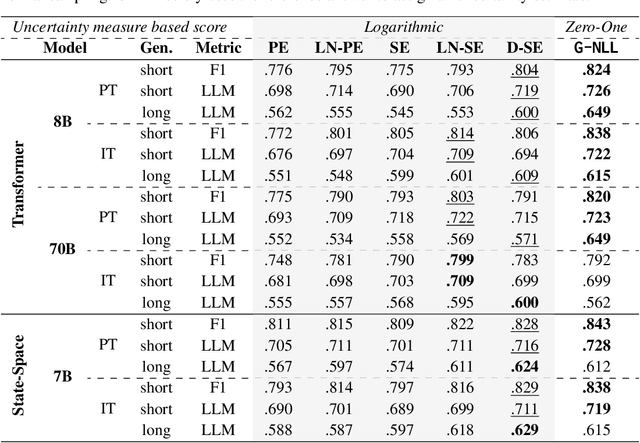
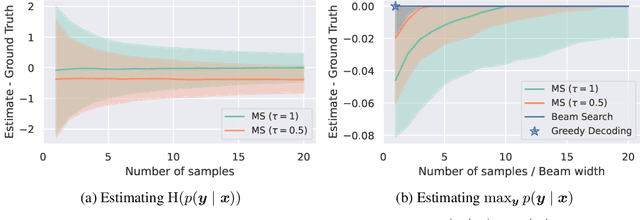
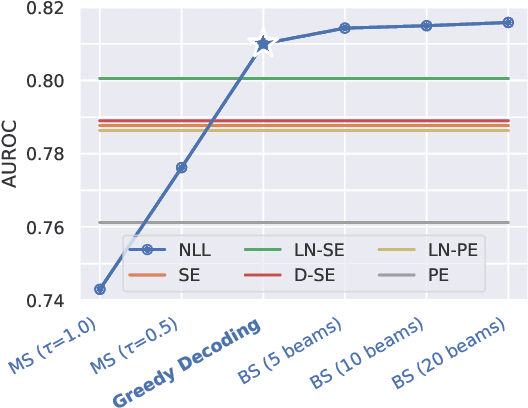
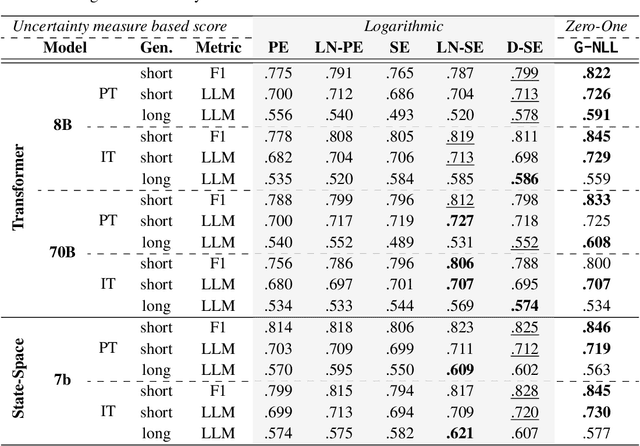
Abstract:Large Language Models (LLMs) are increasingly employed in real-world applications, driving the need to evaluate the trustworthiness of their generated text. To this end, reliable uncertainty estimation is essential. Since current LLMs generate text autoregressively through a stochastic process, the same prompt can lead to varying outputs. Consequently, leading uncertainty estimation methods generate and analyze multiple output sequences to determine the LLM's uncertainty. However, generating output sequences is computationally expensive, making these methods impractical at scale. In this work, we inspect the theoretical foundations of the leading methods and explore new directions to enhance their computational efficiency. Building on the framework of proper scoring rules, we find that the negative log-likelihood of the most likely output sequence constitutes a theoretically grounded uncertainty measure. To approximate this alternative measure, we propose G-NLL, which has the advantage of being obtained using only a single output sequence generated by greedy decoding. This makes uncertainty estimation more efficient and straightforward, while preserving theoretical rigor. Empirical results demonstrate that G-NLL achieves state-of-the-art performance across various LLMs and tasks. Our work lays the foundation for efficient and reliable uncertainty estimation in natural language generation, challenging the necessity of more computationally involved methods currently leading the field.
 Add to Chrome
Add to Chrome Add to Firefox
Add to Firefox Add to Edge
Add to Edge